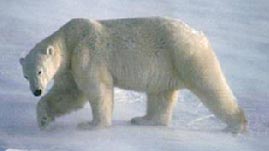Teachers' Domain - Digital Media for the Classroom and Professional Development
User: Preview

Source: Woods Hole Oceanographic Institution



In this interactive activity adapted from the Woods Hole Oceanographic Institution, learn about how environmental conditions in the Arctic influence the northern polar ecosystem. Investigate the variety of organisms that inhabit this unique ecosystem. Additional information details the members and relationships that form its complex food web and discusses the potential consequences of climate change on Arctic life.
Because Earth is tilted on its axis as it orbits the Sun, one pole is exposed to the Sun's light while the other is pitched largely in darkness. The dramatic seasonal variation that results in polar regions influences their physical environments as well as the kinds of life that inhabit them.
The Arctic consists of the ice-covered Arctic Ocean, several smaller seas, and surrounding lands, which include Greenland and the northernmost parts of Europe, Asia, and North America. Land areas support wildlife year-round, including foxes and caribou, and a variety of plants. Although snow covers most of the coastal terrain during winter, it is mostly free of snow and ice during summer, when it becomes a popular destination for migratory animals that use the lush tundra for raising their young.
Arctic ice plays an important role in the region's marine ecology. The sea ice, which extends south in winter—covering approximately 15 million square kilometers (5.6 million square miles)—shrinks to about half its area in summer. Melted snow and ice from land flow into coastal waters, bringing with them important sediments that create estuaries and deltas with salt marshes and mudflats. Harboring crustaceans, mollusks, worms, and small fish, these make ideal breeding and feeding grounds, particularly for birds.
Nutrients in Arctic waters, which derive from terrestrial runoff, deep-water upwelling, and particulates in the atmosphere, support the growth of plankton and algae. There are several species of plankton and algae that grow in a variety of marine habitats, including the ocean's surface, in and under the ice, and in open waters. Algae are adapted to grow at low temperatures and can also grow in the lower-light conditions that exist under ice. As the most important primary producers of the Arctic, they directly and indirectly support a wide variety of marine life that includes zooplankton, fish, jellyfish, seals, walruses, and whales.
Arctic life forms have evolved unique physical adaptations that permit living in extreme environmental conditions. Walruses and seals have a thick layer of blubber that serves to insulate their cores from the cold water and winds. Certain fish species have an internal source of "antifreeze" that keeps their body temperature just above freezing. And because the air spaces that form between snowflakes trap heat, even small, non-hibernating animals such as mice can be active in and survive the bitter cold of winter.
Global warming has been pronounced in the Arctic, with average winter temperatures rising as much as 3 to 4°C over the last half-century. Scientists have been able to document how increased temperatures are affecting the region and its complex food web. One important member of the Arctic, the polar bear, has become a symbol of the effects global warming is already having. This animal is particularly vulnerable because its primary habitat, the Arctic sea ice, is shrinking.
 Loading Standards
Loading Standards Teachers' Domain is proud to be a Pathways portal to the National Science Digital Library.
Teachers' Domain is proud to be a Pathways portal to the National Science Digital Library.
